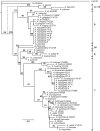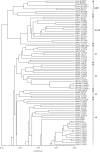A study of the relationships of cultivated peanut (Arachis hypogaea) and its most closely related wild species using intron sequences and microsatellite markers
- PMID: 23131301
- PMCID: PMC3523650
- DOI: 10.1093/aob/mcs237
A study of the relationships of cultivated peanut (Arachis hypogaea) and its most closely related wild species using intron sequences and microsatellite markers
Abstract
Background and aims: The genus Arachis contains 80 described species. Section Arachis is of particular interest because it includes cultivated peanut, an allotetraploid, and closely related wild species, most of which are diploids. This study aimed to analyse the genetic relationships of multiple accessions of section Arachis species using two complementary methods. Microsatellites allowed the analysis of inter- and intraspecific variability. Intron sequences from single-copy genes allowed phylogenetic analysis including the separation of the allotetraploid genome components.
Methods: Intron sequences and microsatellite markers were used to reconstruct phylogenetic relationships in section Arachis through maximum parsimony and genetic distance analyses.
Key results: Although high intraspecific variability was evident, there was good support for most species. However, some problems were revealed, notably a probable polyphyletic origin for A. kuhlmannii. The validity of the genome groups was well supported. The F, K and D genomes grouped close to the A genome group. The 2n = 18 species grouped closer to the B genome group. The phylogenetic tree based on the intron data strongly indicated that A. duranensis and A. ipaënsis are the ancestors of A. hypogaea and A. monticola. Intron nucleotide substitutions allowed the ages of divergences of the main genome groups to be estimated at a relatively recent 2·3-2·9 million years ago. This age and the number of species described indicate a much higher speciation rate for section Arachis than for legumes in general.
Conclusions: The analyses revealed relationships between the species and genome groups and showed a generally high level of intraspecific genetic diversity. The improved knowledge of species relationships should facilitate the utilization of wild species for peanut improvement. The estimates of speciation rates in section Arachis are high, but not unprecedented. We suggest these high rates may be linked to the peculiar reproductive biology of Arachis.
Figures



Similar articles
-
Genetic diversity of peanut (Arachis hypogaea L.) and its wild relatives based on the analysis of hypervariable regions of the genome.BMC Plant Biol. 2004 Jul 14;4:11. doi: 10.1186/1471-2229-4-11. BMC Plant Biol. 2004. PMID: 15253775 Free PMC article.
-
Genetic relationships among seven sections of genus Arachis studied by using SSR markers.BMC Plant Biol. 2010 Jan 20;10:15. doi: 10.1186/1471-2229-10-15. BMC Plant Biol. 2010. PMID: 20089171 Free PMC article.
-
Comparative mapping in intraspecific populations uncovers a high degree of macrosynteny between A- and B-genome diploid species of peanut.BMC Genomics. 2012 Nov 10;13:608. doi: 10.1186/1471-2164-13-608. BMC Genomics. 2012. PMID: 23140574 Free PMC article.
-
A high-density genetic map of Arachis duranensis, a diploid ancestor of cultivated peanut.BMC Genomics. 2012 Sep 11;13:469. doi: 10.1186/1471-2164-13-469. BMC Genomics. 2012. PMID: 22967170 Free PMC article.
-
Genetic mapping of wild introgressions into cultivated peanut: a way toward enlarging the genetic basis of a recent allotetraploid.BMC Plant Biol. 2009 Aug 3;9:103. doi: 10.1186/1471-2229-9-103. BMC Plant Biol. 2009. PMID: 19650911 Free PMC article.
Cited by
-
First insight into divergence, representation and chromosome distribution of reverse transcriptase fragments from L1 retrotransposons in peanut and wild relative species.Genetica. 2015 Feb;143(1):113-25. doi: 10.1007/s10709-015-9820-y. Epub 2015 Jan 30. Genetica. 2015. PMID: 25633099
-
Characterization and Comparative Analysis of RWP-RK Proteins from Arachis duranensis, Arachis ipaensis, and Arachis hypogaea.Int J Genomics. 2020 Aug 27;2020:2568640. doi: 10.1155/2020/2568640. eCollection 2020. Int J Genomics. 2020. PMID: 32908854 Free PMC article.
-
Groundnut improvement: use of genetic and genomic tools.Front Plant Sci. 2013 Feb 25;4:23. doi: 10.3389/fpls.2013.00023. eCollection 2013. Front Plant Sci. 2013. PMID: 23443056 Free PMC article.
-
New tools to screen wild peanut species for aflatoxin accumulation and genetic fingerprinting.BMC Plant Biol. 2018 Aug 15;18(1):170. doi: 10.1186/s12870-018-1355-9. BMC Plant Biol. 2018. PMID: 30111278 Free PMC article.
-
Genetic improvement of peanut (Arachis hypogea L.) genotypes by developing short duration hybrids.Saudi J Biol Sci. 2022 Apr;29(4):3033-3039. doi: 10.1016/j.sjbs.2022.01.032. Epub 2022 Jan 20. Saudi J Biol Sci. 2022. PMID: 35531144 Free PMC article.
References
-
- Baldwin B, Sanderson M, Porter J, Wojciechowski M, Campbell C, Donoghue M. The ITS region of nuclear ribosomal DNA: a valuable source of evidence on angiosperm phylogeny. Annals of the Missouri Botanical Garden. 1995;82:247–277.
-
- Barkley NA, Dean RE, Pittman RN, Wang ML, Holbrook CC, Pederson GA. Genetic diversity of cultivated and wild-type peanuts evaluated with M13-tailed SSR markers and sequencing. Genetic Research. 2007;89:93–106. - PubMed
-
- Bechara M, Moretzsohn MC, Palmieri D, et al. Phylogenetic relationships in genus Arachis based on ITS and 5·8S rDNA sequences. BMC Plant Biology. 2010;10(255) http://dx.doi.org/10.1186/1471-2229-10-255 . - PMC - PubMed
-
- Bertioli D, Moretzsohn M, Madsen L, et al. An analysis of synteny of Arachis with Lotus and Medicago sheds new light on the structure, stability and evolution of legume genomes. BMC Genomics. 2009;10(45) http://dx.doi.org/10.1186/1471-2164-10-45 . - PMC - PubMed
Publication types
MeSH terms
Substances
LinkOut - more resources
Full Text Sources
Other Literature Sources

